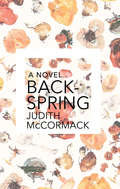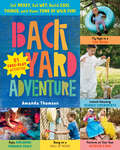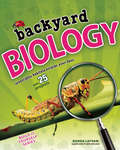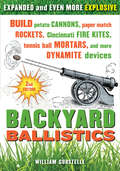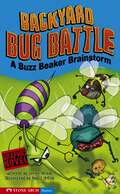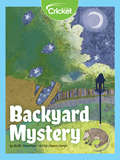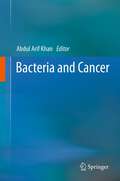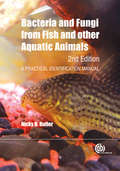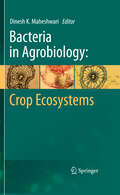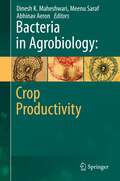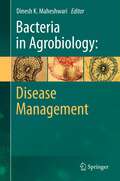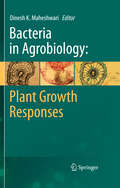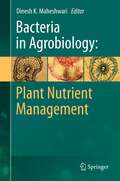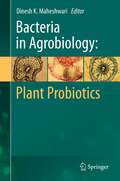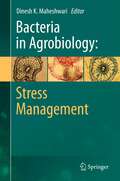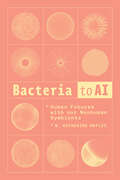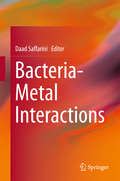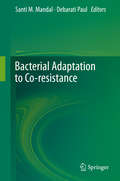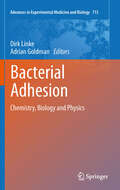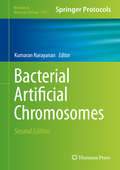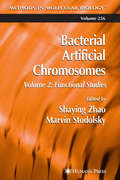- Table View
- List View
Backspring
by Judith Mccormack"A joy to read. "—Nino Ricci "A wonderfully and uniquely gifted storyteller. "—Midwest Book Review Eduardo, an architect from Lisbon, has come to Montreal to be with his wife Geneviève. Geneviève researches fungi and likes to catalog her orgasms. But when Eduardo is caught in an explosion and rumors of arson begin to circulate, both his marriage and his fledgling architecture firm verge on collapse. Gorgeous, colorful, and richly described, Backspring is a sensual taxonomy of desire. Judith McCormack, born near Chicago, has been nominated for the Commonwealth Writers Prize and the Rogers Writers' Trust Fiction Award.
Backyard Adventure: Get Messy, Get Wet, Build Cool Things, and Have Tons of Wild Fun! 51 Free-Play Activities
by Amanda ThomsenThe backyard has long been a space associated with recreation and relaxation, a private patch of earth to escape to, and a springboard for the imagination. In her signature style and drawing on her personal experience as a mother, gardener, and author, Amanda Thomsen encourages kids to create kingdoms of their own making, right in their own backyards. With whimsical projects for every season and any setting, from forest to pavement, fun-seeking kids and their families will rediscover the yard as a place for inspired play, using repurposed materials and existing features of outdoor spaces. Whether they’re creating tiny gardens inhabited by action figures, weaving a secret hideaway out of a loom of twine and twigs, or setting sidewalk cracks on fire with Coffeemate, Backyard Adventure lets kids of all ages turn their yards into a place they can call their own. This publication conforms to the EPUB Accessibility specification at WCAG 2.0 Level AA.
Backyard BIOLOGY
by Donna Latham Beth HetlandBIOLOGY IS THE STUDY OF LIFELife is everywhere, thriving in the city and in the country, teeming in ecosystems around the planet-in deserts, oceans, and even the Arctic. And life is right outside your door! Backyard Biology invites children ages 9 and up to investigate living things-especially in yards, parks, nature areas, and playgrounds. Trivia and fun facts bring animals, plants, and microorganisms to life, in all their wonder.Readers become Nature Detectives with activities and projects that encourage children to make discoveries. Children will construct a plankton net to collect pond samples, and they'll grow microorganisms in a Winogradsky Column. They'll discover what mystery plants sprout from collected soil samples and build a rolypoly habitat. When children experiment with phototropism and geotropism, they'll discover the ways plants move. In Backyard Biology, children will scout out different habitats to observe and investigate-and do their part to protect them.
Backyard Ballistics: Build Potato Cannons, Paper Match Rockets, Cincinnati Fire Kites, Tennis Ball Mortars, and More Dynamite Devices
by William GurstelleThis bestselling DIY handbook now features new and expanded projects, enabling ordinary folks to construct 16 awesome ballistic devices in their garage or basement workshops using inexpensive household or hardware store materials and this step-by-step guide. Clear instructions, diagrams, and photographs show how to build projects ranging from the simple match-powered rocket to the more complex tabletop catapult and the offbeat Cincinnati fire kite. The classic potato cannon has a new evil twin--the piezo-electric spud gun--and the electromagnetic pipe gun has joined the company of such favorites as the tennis ball mortar. With a strong emphasis on safety, the book also gives tips on troubleshooting, explains the physics behind the projects, and profiles scientists and extraordinary experimenters such as Alfred Nobel, Robert Goddard, and Isaac Newton. This book will be indispensable for the legions of backyard toy-rocket launchers and fireworks fanatics who wish every day was the fourth of July.
Backyard Biodiesel
by Lyle Estill Bob ArmantroutSmall-scale home biodiesel production holds a singular attraction for the do-it-yourself enthusiast. While perhaps it can't save the world, this unique renewable fuel is economical, fun to make, better for the environment, and will help you reduce your dependence on Big Oil. And getting started is easier than you think.Backyard Biodiesel is written by two recognized experts in the field of small-scale biofuels. This comprehensive hands-on, practical, DIY guide includes: The basics of small-scale brewing--recipes, strategies, and technologies Advanced backyard analytics and troubleshooting Safety considerations and regulatory issues Topping up the tank--how to put your biodiesel to work for youMaking your own fuel is not only possible, it is rewarding. Designed to be accessible to everyone from readers with no prior technical expertise to alternative energy buffs, Backyard Biodiesel is a must-read for any aspiring brewer, packed with everything you need to get up and running quickly and safely.Lyle Estill is the president and co-founder of Piedmont Biofuels and the author of Industrial Evolution, Small is Possible, and Small Stories, Big Changes. He has won numerous awards for his commitment to sustainability, outreach, community development, and leadership.Bob Armantrout helped to manage four commercial biodiesel plants before joining Piedmont Biofuels in 2007. He works as an instructor at Central Carolina Community College, where he spearheads an innovative two-year biofuels degree program.
Backyard Bird Song: Eastern and Central North America (Peterson's Field Guides)
by Robert Lawson Richard K. Walton"Backyard Bird Song introduces you to the fascinating world of bird song. Used in conjunction with my Field Guide to the Birds, this audio guide may give you a new perspective on a familiar place, your own backyard. "In this audio guide, Dick Walton and Bob Lawson have grouped 28 of the most common bird species according to similarity of song. Just as my Field Guide shows what to look for, Backyard Bird Song points out exactly what to listen for to tell one bird from another." -Roger Tory Peterson With this audio guide, you can learn to identify your favorite birds by their songs and calls alone. Backyard Bird Song includes 28 of the most common backyard birds, such as the American Robin, Song Sparrow, and the Downy Woodpecker, arranged in groups with similar vocalizations.
Backyard Bug Battle: A Buzz Beaker Brainstorm (A Buzz Beaker Brainstorm)
by Scott NickelBuzz spills an invention of his Dad's super-fast grow juice, and creates gigantic insects and flowers. Written in graphic-novel format.
Backyard Mystery
by Buffy SilvermanEmma and her father finish their walk with their dog Dakota–what Dakota finds in the backyard leaves them surprised. What they believed had been an injured animal has now disappeared! Emma takes pictures of the tracks to identify the animal that left them behind. Was the missing animal an opossum that is known for playing dead? Find out who helps Emma solve this backyard mystery!
Bacteria and Cancer
by Abdul Arif KhanBacterial infections cause substantial morbidity and mortality in cancer patients. These infections always remained enigmatic due to initial reluctance of cancer researchers in understanding their etiologic potential. Etiological association of bacteria with cancer gained credibility after discovery of carcinogenic potential of Helicobacter pylori. Moreover, other suspected associations including Salmonella typhi and gallbladder cancer, Streptococcus bovis and colon cancer, Chlamydia psittaci and ocular adnexal lymphoma and Chlamydia pneumoniae with lung cancer, etc. are looking for a legitimate appraisal to unravel their etiologic potential without prejudice. In contrary, bacteria also show protective role in certain types of cancer. Certain agents derived from bacteria are successfully in practice for the management of cancer. The integrate association of bacteria and cancer is evident in both positive and negative aspects. The role of bacteria in cancer etiology and treatment is vigorously studied since last few years. Present book tries to provide current status of research undergoing in above direction, with the glimpses of future possibility for using microbiological knowledge in the management of this deadly killer. This book will interest specialists dealing with cancer associated infectious complications, researchers working in the field of cancer biology, teachers and scientists in the field of microbiology, biotechnology, medicine and oncology. The unique coverage of bacteriology and cancer association in both positive and negative way can usher into development of novel thrust area for microbiology students and experts.
Bacteria and Fungi from Fish and Other Aquatic Animals
by Nicky BullerThis practical book provides an updated resource for the identification of bacteria found in animals inhabiting the aquatic environment, illustrated with colour photos. It contains expanded biochemical identification tables to include newly identified pathogenic and saprophytic bacteria, molecular identification tests now available for a greater number of aquatic bacterial pathogens, more information on the pathogenesis and virulence of each organism and new coverage of traditional and molecular identification of fungal pathogens and quality assurance standards for laboratories.
Bacteria and Fungi from Fish and Other Aquatic Animals: A Practical Identification Manual
by Nicky BullerThis practical book provides an updated resource for the identification of bacteria found in animals inhabiting the aquatic environment, illustrated with colour photos. It contains expanded biochemical identification tables to include newly identified pathogenic and saprophytic bacteria, molecular identification tests now available for a greater number of aquatic bacterial pathogens, more information on the pathogenesis and virulence of each organism and new coverage of traditional and molecular identification of fungal pathogens and quality assurance standards for laboratories.
Bacteria in Agrobiology: Crop Ecosystems
by Dinesh K. MaheshwariThe future of agriculture strongly depends on our ability to enhance productivity without sacrificing long-term production potential. An ecologically and economically sustainable strategy is the application of microorganisms, such as the diverse bacterial species of plant growth promoting bacteria (PGPB). The use of these bio-resources for the enhancement of crop productivity is gaining worldwide importance. Bacteria in Agrobiology: Crop Ecosystems describes the beneficial role of plant growth promoting bacteria with special emphasis on oil yielding crops, cereals, fruits and vegetables. Chapters present studies on various aspects of bacteria-plant interactions, soil-borne and seed-borne diseases associated with food crops such as rice, sesame, peanuts, and horticultural crops. Further reviews describe technologies to produce inoculants, the biocontrol of post harvest pathogens as a suitable alternative to agrochemicals, and the restoration of degraded soils.
Bacteria in Agrobiology: Crop Productivity
by Dinesh K. Maheshwari Abhinav Aeron Meenu SarafThe future of agriculture greatly depends on our ability to enhance productivity without sacrificing long-term production potential. The application of microorganisms, such as the diverse bacterial species of plant growth promoting rhizobacteria (PGPR), represents an ecologically and economically sustainable strategy. The use of these bio-resources for the enhancement of crop productivity is gaining importance worldwide. Bacteria in Agrobiology: Crop Productivity focus on the role of beneficial bacteria in crop growth, increased nutrient uptake and mobilization, and defense against phytopathogens. Diverse group of agricultural crops and medicinal plants are described as well as PGPR-mediated bioremediation leading to food security.
Bacteria in Agrobiology: Disease Management
by Dinesh K. MaheshwariThe future of agriculture greatly depends on our ability to enhance productivity without sacrificing long-term production potential. The application of microorganisms, such as the diverse bacterial species of plant growth promoting bacteria (PGPB), represents an ecologically and economically sustainable strategy. The use of these bio-resources for the enhancement of crop productivity is gaining importance worldwide. "Bacteria in Agrobiology: Disease Management" discusses various aspects of biological control and disease suppression using bacteria. Topics covered include: fluorescent pseudomonads; siderophore-producing PGPR; pseudomonas inoculants; bacillus-based biocontrol agents; bacterial control of root and tuber crop diseases; fungal pathogens of cereals; soil-borne fungal pathogens; peronosporomycete phytopathogens; and plant parasitic nematodes.
Bacteria in Agrobiology: Plant Growth Responses
by Dinesh K. MaheshwariThe future of agriculture strongly depends on our ability to enhance productivity without sacrificing long-term production potential. An ecologically and economically sustainable strategy is the application of microorganisms, such as the diverse bacterial species of plant growth promoting bacteria (PGPB). The use of these bio-resources for the enhancement of crop productivity is gaining worldwide importance. "Bacteria in Agrobiology: Plant Growth Responses" describes the application of various bacteria in plant growth promotion and protection, including symbiotic, free living, rhizospheric, endophytic, methylotrophic, diazotrophic and filamentous species.
Bacteria in Agrobiology: Plant Nutrient Management
by Dinesh K. MaheshwariThe future of agriculture strongly depends on our ability to enhance productivity without sacrificing long-term production potential. An ecologically and economically sustainable strategy is the application of microorganisms, such as the diverse bacterial species of plant growth promoting bacteria (PGPB). The use of these bio-resources for the enhancement of crop productivity is gaining worldwide importance. "Bacteria in Agrobiology: Plant Nutrient Management" focus on the management of plant nutrient to support plant growth and development. The topics treated in this book include mechanisms of plant growth promoting rhizobacteria, zinc and phosphate solubilizing microorganisms, sulfur oxidizing bacteria, ACC deaminase, siderophores, phytohormones, quorum-sensing, biofilms, antibiotics, volatiles, denitrification and integrated nutrient management.
Bacteria in Agrobiology: Plant Probiotics
by Dinesh K. MaheshwariThe future of agriculture strongly depends on our ability to enhance productivity without sacrificing long-term production potential. An ecologically and economically sustainable strategy is the application of microorganisms, such as the diverse bacterial species of plant growth promoting bacteria (PGPB). The use of these bio-resources for the enhancement of crop productivity is gaining worldwide importance. "Bacteria in Agrobiology: Plant Probiotics" discusses the current trends and future prospects of beneficial microorganisms acting as Probiotics. Topics include the application for the aboveground fitness of plants, in mountain ecosystems, in tropical and Mediterranean forests, and in muga sericulture. Further aspects are Arabidopsis as a model system for the diversity and complexity of plant responses, plant parasitic nematodes, nitrogen fixation and phosphorus nutrition.
Bacteria in Agrobiology: Stress Management
by Dinesh K. MaheshwariThe future of agriculture strongly depends on our ability to enhance productivity without sacrificing long-term production potential. An ecologically and economically sustainable strategy is the application of microorganisms, such as the diverse bacterial species of plant growth promoting bacteria (PGPB). The use of these bio-resources for the enhancement of crop productivity is gaining worldwide importance. "Bacteria in Agrobiology: Stress Management" covers the major aspects on PGPR in amelioration of both abiotic and biotic stresses. PGPR mediated in priming of plant defense reactions, nutrient availability and management in saline and cold environment, hormonal signaling, ACC deaminase and its role in ethylene regulation under harsh conditions are suitably described.
Bacteria to AI: Human Futures with our Nonhuman Symbionts
by N. Katherine HaylesA new theory of mind that includes nonhuman and artificial intelligences. The much-lauded superiority of human intelligence has not prevented us from driving the planet into ecological disaster. For N. Katherine Hayles, the climate crisis demands that we rethink basic assumptions about human and nonhuman intelligences. In Bacteria to AI, Hayles develops a new theory of mind—what she calls an integrated cognitive framework (ICF)—that includes the meaning-making practices of lifeforms from bacteria to plants, animals, humans, and some forms of artificial intelligence. Through a sweeping survey of evolutionary biology, computer science, and contemporary literature, Hayles insists that another way of life, with ICF at its core, is not only possible but necessary to safeguard our planet’s future
Bacteria-Metal Interactions
by Daad SaffariniThis book provides a detailed description and analysis of the reduction and metabolism of metals and metalloids by sulfate reducing bacteria. The molecular mechanisms of bacterial resistance to copper are examined as well as extracellular electron transfer and bacterial metal oxide respiration. Furthermore, in this book enrichment, isolation, and physiology of magnetotactic bacteria are discussed. The interactions of bacteria with metals in natural environments and their role in metal cycling have been studied for decades. Advances in studies of bacteria-metal interactions identified numerous important aspects of these interactions, such as bioremediation of metal-contaminated environments, the role of metals in redox reactions and other cellular functions, as well as the role of metals in toxicity and infection. Microbiologists, environmental scientists, and students interested in microbe interactions with metals and their effect on the environment and their application in biotechnology will be interested in the topics discussed in the book.
Bacterial Adaptation to Co-resistance
by Santi M. Mandal Debarati PaulThe proposed book aims to understand the mechanism of survival of microorganisms in response to chemical stress in various ecological niches that suffer direct human intervention, more so the agricultural, domestic and hospital settings. Microbicides (e.g. disinfectants, antiseptics, fungicides, algaecides, insecticides and pesticides) are used rampantly to control undesirable microbes. Insecticides and pesticides are routinely used in agriculture which directly affect the microbial population in farms, orchards and fields. Health care environments are always stressed with disinfectants and antibiotics. It is always probable that microbicide-stressed microorganisms are in a dynamic state, displaced from one niche to the other. Some soil and water borne bacteria or their resistance determinants are also getting prominence in hospital settings after suffering selective pressure from agricides. In order to reveal the survival strategies of microbicidal-resistant microbes, it is of prime importance to know the mode of action of these complete range of microbicides (agricides to antibiotics). The present book intends to address these issues. There will be several chapters dealing with tolerance and cross resistance in microbes and bacteria in particular, dwelling in various niches. Till date, there is no consensus among scientists in theorizing molecular mechanisms to explain bacterial tolerance and their cross resistance to agricides and antibiotics.
Bacterial Adhesion: Chemistry, Biology and Physics (Advances in Experimental Medicine and Biology #715)
by Dirk Linke Adrian GoldmanOver the last few years, bacterial adhesion has become a more and more important and active scientific area, but the field lacks communication and scientific exchange between medical and microbiology researchers who work with the relevant biological systems, and biochemists, structural biologists and physicists, who know and understand the physical methods best suited to investigate the phenomenon at the molecular level. The field consequently would benefit from a cross-disciplinary conference enabling such communication. This book tries to bridge the gap between the disciplines.
Bacterial Amyloids: Methods and Protocols (Methods in Molecular Biology #2538)
by Véronique Arluison Frank Wien Andrés MarcoletaThis detailed volume introduces different methods to assess the structure and folding of bacterial amyloids and analyze their functions, either in vitro or in vivo. Despite their initial association with neurodegenerative diseases, there is now increasing evidence of alternative roles for amyloids, with beneficial aspects for cells. In particular, prokaryotes use amyloids as functional assemblies, where they are key players in the cell's physiology. Written for the highly successful Methods in Molecular Biology series, chapters include introductions to their respective topics, lists of the necessary materials and reagents, step-by-step, readily reproducible laboratory protocols, and tips on troubleshooting and avoiding known pitfalls. Authoritative and up-to-date, Bacterial Amyloids: Methods and Protocols is an ideal guide for experts and novices alike to further explore these crucial protein assemblies.
Bacterial Artificial Chromosomes, Second Edition (Methods in Molecular Biology #1227)
by Kumaran NarayananBacterial Artificial Chromosomes, Second Edition expands upon the previous edition with current, detailed methods developed for working with BACs. Updated chapters included in this edition present fundamental techniques used for BAC construction and characterization, advanced procedures for introducing modifications, achieving gene expression from BAC vectors, applications of BACs in model organisms, and medical genetics and drug discovery. Written in the highly successful Methods in Molecular Biology series format, chapters include introductions to their respective topics, lists of the necessary materials and reagents, step-by-step reproducible laboratory protocols, and tips to troubleshoot and avoid known pitfalls. Authoritative and cutting-edge, Bacterial Artificial Chromosomes, Second Edition seeks to aid scientists in advancing their research using these exciting BAC techniques and strategies.
Bacterial Artificial Chromosomes, Volume 2: Volume 2: Functional Studies (Methods in Molecular Biology #256)
by Shaying Zhao Marvin StodolskyExpert investigators describe not only the classic methods, but also the many novel techniques they have perfected for the transfer of large DNAs into the cells of both microbes and animals via large-insert recombinant DNAs. Volume 1 presents readily reproducible techniques for library construction, physical mapping, and sequencing.. An accompanying volume, Volume 2: Functional Studies, provides a wide variety of methods and applications for functional analysis of the DNA-transformed organisms. Besides protocols, each chapter includes scientific reviews, software tools, database resources, genome sequencing strategies, and illustrative case studies.
